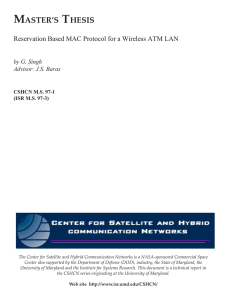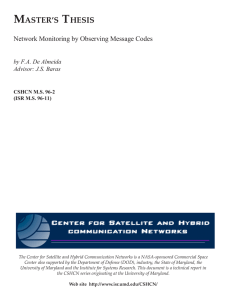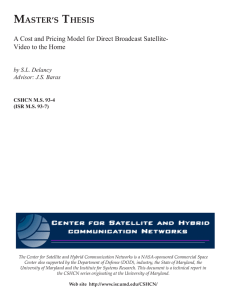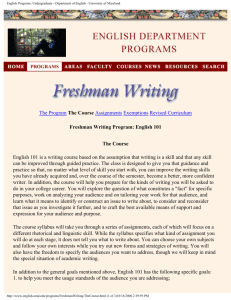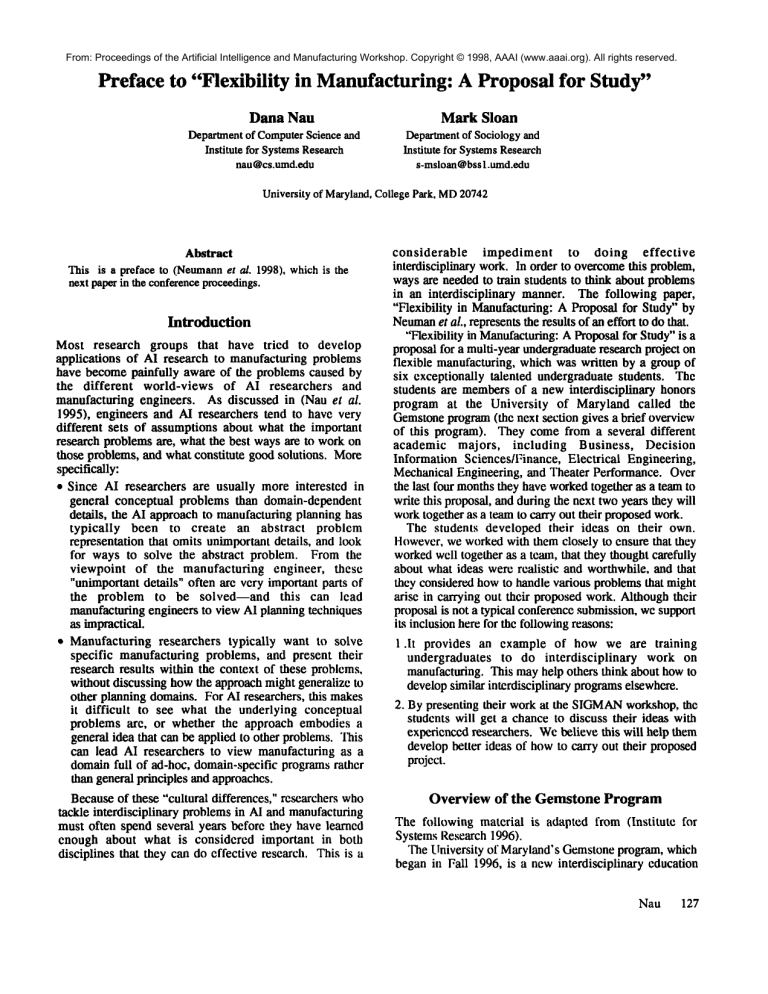
From: Proceedings of the Artificial Intelligence and Manufacturing Workshop. Copyright © 1998, AAAI (www.aaai.org). All rights reserved.
Preface to "Flexibility in Manufacturing:A Proposal for Study"
Dana Nan
Departmentof ComputerScience and
Institute for Systems
Research
nau@cs.umd.edu
Mark Sloan
Departmentof Sociologyand
Institute for SystemsResearch
s-msloan@bss
l.umd.edu
University of Maryland,CollegePark, MD20742
Abstract
This is a preface to (Neumann
et al. 1998), whichis the
next paperin the conferenceproceedings.
Introduction
Most research groups that have tried to develop
applications of AI research to manufacturing problems
have become painfully aware of the problems caused by
the different
world-views of AI researchers
and
manufacturing engineers. As discussed in (Nan et al.
1995), engineers and AI researchers tend to have very
different sets of assumptions about what the important
research problems are, what the best ways are to work on
those problems, and what constitute good solutions. More
specifically:
¯ Since AI researchers are usually more interested in
general conceptual problems than domain-dependent
details, the AI approach to manufacturing planning has
typically
been to create an abstract
problem
representation that omits unimportant details, and look
for ways to solve the abstract problem. From the
viewpoint of the manufacturing engineer, these
"unimportant details" often are very important parts of
the problem to be solved--and
this can lead
manufacturing engineers to view AI planning techniques
as impractical.
¯ Manufacturing researchers typically want to solve
specific manufacturing problems, and present their
research results within the context of these problems,
without discussing howthe approach might generalize to
other planning domains. For AI researchers, this makes
it difficult to see what the underlying conceptual
problems are, or whether the approach embodies a
general idea that can be applied to other problems. This
can lead AI researchers to view manufacturing as a
domainfull of ad-hoc, domain-specific programs rather
than general principles and approachcs.
Becauseof these "cultural differences," researchers who
tackle interdisciplinary problems in AI and manufacturing
must often spend several years before they have learned
enough about what is considered important in both
disciplines that they can do effective research. This is a
considerable
impediment
to doing effective
interdisciplinary work. In order to overcomethis problem,
ways are needed to train students to think about problems
in an interdisciplinary
manner. The following paper,
"Flexibility in Manufacturing: A Proposal for Study" by
Neuman
et al., represents the results of an effort to do that.
"Flexibility in Manufacturing:A Proposal for Study" is a
proposal for a multi-year undergraduateresearch project on
flexible manufacturing, which was written by a group of
six exceptionally talented undergraduate students. The
students are membersof a new interdisciplinary honors
program at the University of Maryland called the
Gemstoneprogram(thc next section gives a brief overview
of this program). They come from a several different
academic majors, including
Business, Decision
Information Sciences/Finance, Electrical Engineering,
Mechanical Engineering, and Theater Performance. Over
the last four monthsthey have workedtogether as a team to
write this propesal, and during the next two years they will
worktogether as a team to carry out their proposedwork.
The students developed their ideas on their own.
However,we workedwith them closely to ensure that they
workedwell together as a reran, that they thought carefully
about what ideas were realistic and worthwhile, and that
they considered howto handle various problems that might
arise in carrying out their proposed work. Althoughtheir
proposal is not a typical conference submission, we support
ik~ inclusion here for the followingreasons:
1 .It provides an example of how we are training
undergraduates to do interdisciplinary
work on
manufacturing. This mayhelp others think about howto
develop similar interdisciplinary programselsewhere.
2. By presenting their work at the SIGMAN
workshop, the
students will get a chance to discuss their ideas with
experienced researchers. Webelieve this will help them
develop better ideas of howto carry out their proposed
project.
Overview of the Gemstone Program
The following material is adapted from (Institute for
Systems Research 1996).
The University of Maryland’s Gemstoneprogram, which
began in Fall 1996, is a new interdisciplinary education
Nau
127
solution
of major
societal problems,"
for ofundergraduate
honors and
students.
The Gemstone
From:program
Proceedings
the Artificial Intelligence
Manufacturing
Workshop. Copyright
© 1998,
AAAI (www.aaai.org).
All rightsDestler
reserved.says.
programplaces students in multidisciplinary teams for their
undergraduate years. Each team
undertakes a long-term research project addressing a
crucial societal problem such as energy-efficient
transportation,
urban housing, waste management or
biological engineering.
The Gemstoneprogram is administered by the Institute
for Systems Research (ISR). ISR was the natural
organization to lead the effort becauseit is the largest unit
on campus dedicated to interdisciplinary
research and
education, and already had a number of complementary
programsin place for high school students, undergraduates
and graduate students. ISR faculty and staff are involved in
designing the Gemstone program in addition to their
administrative duties.
Morethan 100 entering freshman students were selected
on the basis of academic promise and their potential to
interact effectively. All are honors students with an average
SATscore of 1400. Each team contains approximately 12
undergraduates from engineering and other sciences,
business and management,behavioral and social sciences,
and the humanities.
The teams take special courses that emphasize the
relationship between technological innovation and social
change from the perspectives of sociology, political
science, history and business. Student teams will meet
regularly during the academic year to investigate and
analyze their assigned problem. By the end of the senior
year, each team will produce a book-length thesis
containing results from background, analysis, design,
testing and implementationstudies as well as a description
of the proposedsolution, its potential societal impact and a
business plan for implementation. Faculty advisors and
selected industry experts in the field evaluate each team’s
proposal.
Students will address an aspect of the problemrelated to
their undergraduate major. Engineering and science majors
will investigate both theoretical
and experimental
technological solutions. Humanities and behavioral and
social sciences students will address the history and
societal impact of the problem, while business and
management majors will concentrate on finance and
marketing issues. Students completing the program are
awarded a Gemstone designation on their baccalaureate
degree.
University officials hope the Gemstoneconcept will help
Maryland stake out a national presence as a leading
innovator in undergraduate education.
William Destler, dean of the A. James Clark School of
Engineering, originated the Gemstone idea. He says it
addresses two of the most commoncriticisms of modern
undergraduate education: the lack of an integrative
experience to provide a context for learning, and the failure
to provide meaningful interactions between
students in different disciplines. "Society has not been as
effective as we might have been at bringing such diverse
talents together towardthe
128
AIMW-98
"The
University of Marylandis a pioneer."
(’ore funding comes from General Electric and AT&T,
which are investing a combinedtotal of S370,000over four
years. Additional support comes from IBMthrough its
Total Quality Programat the University of Maryland.
One Gemstone goal is to incorporate "real life"
experience relevant to the students’ research focus by
providing internships or other work opportunities in
industry and government. For further information alxmt
Gemstone, please contact Vickie J. Claflin, program
coordinator, at
30 !-405-6564; e-mail vclaflin@isr.umd.edu.
References
Institute for Systems Research, 1996. Pioneer ’Gemstone’
Program May Change Undergraduate
Education.
<http://www.isr.umd.edu/ISR/
newsletter/Summer 1996/gemstone.hunl>
Nau, D., Regli, W., and Gupta, S., 1995. AI Planning
Versus Manufacturing-Operation Planning: A (’.a~ Study.
IJCAI-95.
Nemnann, Roscnkranz, Wallace, Walther, Williams, and
Woehr,1998. Flexibility in Manufacturing: A Proposal lbr
Study. 1998 Artificial Intelligence and Manufacturing
Workshop:State of the Art and State of Practice.


